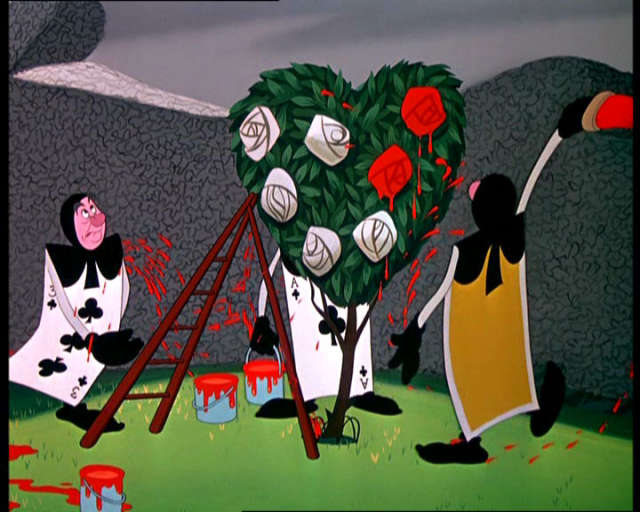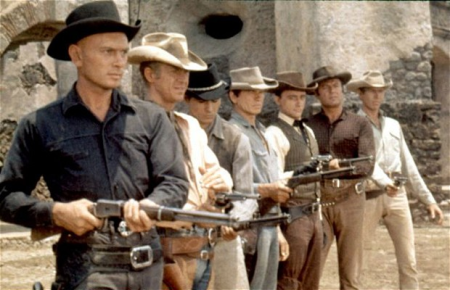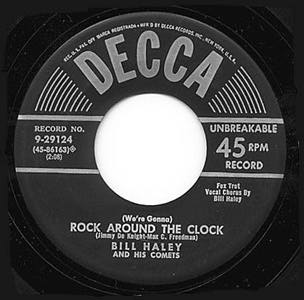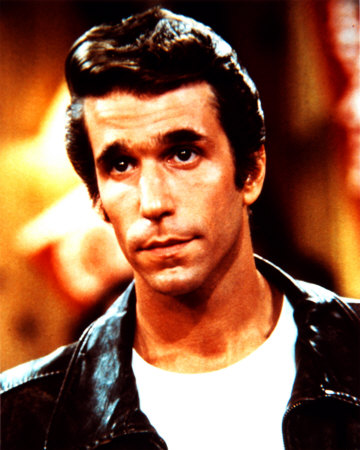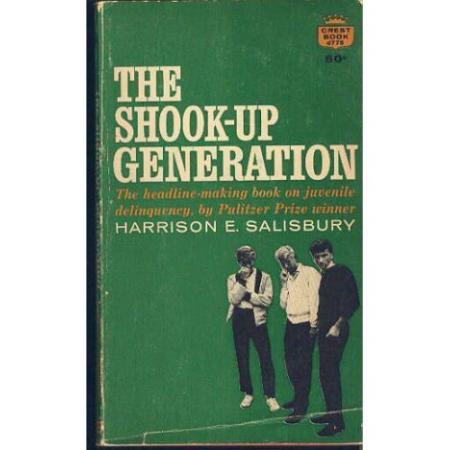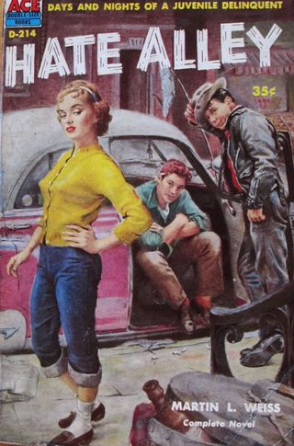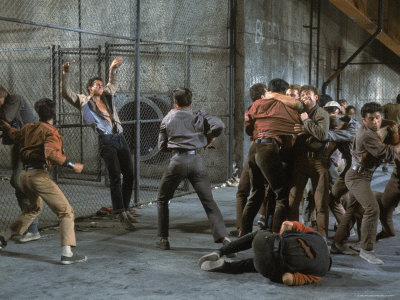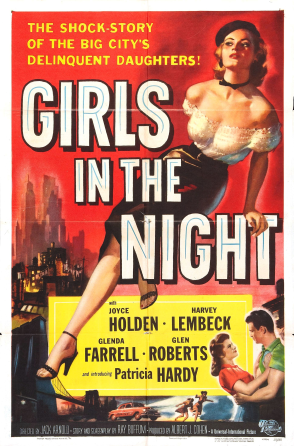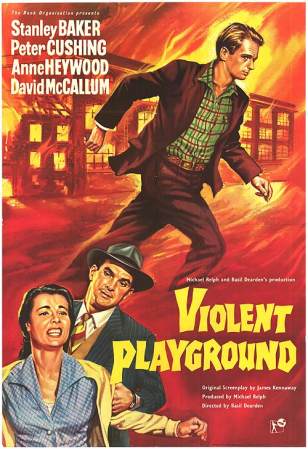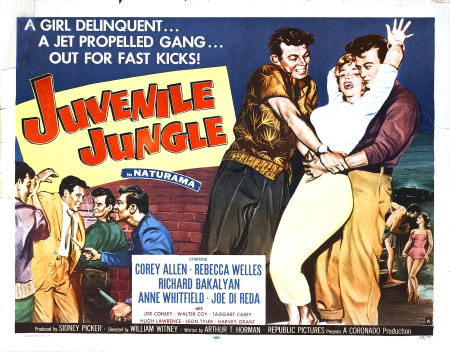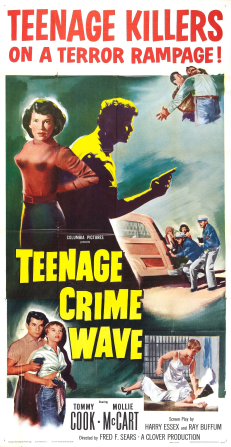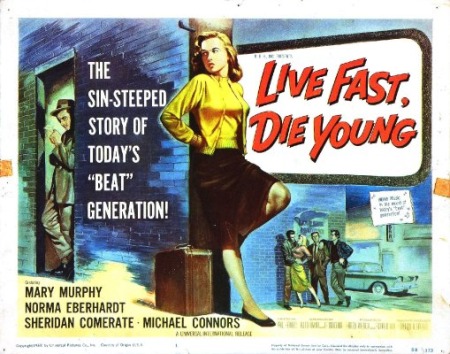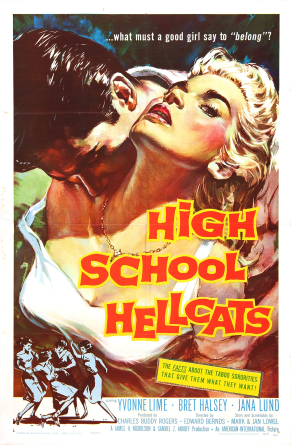Painting a Rosy Past: Part 1
Introduction–Painting a Rosy Past
Alice enters the garden and finds three gardeners, shaped like playing cards, hurriedly painting the white roses of a rose tree. Alice asks why they are painting the roses red, and one of the gardeners (the Two) admits to her that the tree was supposed to be a red rose tree. If the Queen learned about the error, she would cut off their heads. (Alice in Wonderland)
Our personal memories can be almost as demanding as that Queen! We WANT “the past”–of our own youth, or of previous generations–to be the “way we think it should have been.” If facts don’t line up with those desires, we can literally try to deny and cover up the facts. But you don’t need paint. If you have rose-colored nostalgia glasses, the reality of the past can be changed to line up with the demands of your faded, faulty memories.
Passing on a Passion for the Past
Posts on Facebook, and email rants that are copied and re-copied and sent around by CC Mail, often contain gripes from “older people” about how much worse the teens and young adults of today are—rude, disrespectful, immoral, selfish—compared to what things were like in the youth of the writers. For instance, have you seen any posts in your Facebook newsfeed with statements such as these actual ones, with encouragement to hit the “LIKE” button if you are eager to say, essentially, “AMEN. Ain’t it awful how bad it’s gotten? These sure are the Worst of Times!”
- We live in a decaying age. Young people no longer respect their parents. They are rude and impatient.
- When I was young, we were taught to be discreet and respectful of elders, but the present youth are exceedingly disrespectful and impatient of restraint.
- What is happening to our young people? They disrespect their elders, they disobey their parents. They ignore the law. They riot in the streets, inflamed with wild notions. Their morals are decaying. What is to become of them?
- The young people of today think of nothing but themselves. They have no reverence for parents or old age. They are impatient of all restraint. The girls are forward, immodest and unladylike in speech, behavior and dress.
- I think morals are getting much worse. There were no such girls in my time as there are now. When I was 24 or 25 my mother would have knocked me down if I had spoken improperly to her.
As you may have guessed by now, based on the slightly stilted language in the quotes above, these are indeed “actual” statements by real people. But they didn’t come from Facebook, and in fact, aren’t from the 21st century at all. Or even the 20th century:
Number 1: These words were actually inscribed on a 6,000-year-old Egyptian tomb.
Number 2: This comment was made by Hesiod, in the 8th century BC.
Number 3: Plato made this remark in the 4th century BC.
Number 4: This quote is attributed to a man named Peter the Hermit in 1274.
Number 5: And this was what a 60-year-old lady named Charlotte Kirkman testified in 1843, as part of an investigation in Great Britain into the bad behavior of contemporary youth. Lord Ashley, speaking in the House of Commons in the same year, argued that “the morals of the children are tenfold worse than formerly”. (From the webpage 8000 Years of Civilization-threatening Behavior)
Yet there is no question that similar comments, just as passionately sure that these ARE the Worst of Times in terms of youth behavior, and lamenting the disappearance of the Good Old Days, are made all the time on the Internet. Here’s a piece of advice about that notion:
Don’t always be asking, “Where are the good old days?”
Wise folks don’t ask questions like that.
If that advice was just from me, perhaps you would be justified in thinking you can brush it off. Unfortunately, it’s not from me.
It’s from the Bible. Ecclesiastes 7:10.
The author of Ecclesiastes (King Solomon, according to some Bible scholars, but at the very least one of the wisest men of ancient times in Israel) penned that well over 2500 years ago. The quote above was from The Message translation. The King James Version puts it this way:
Say not thou, What is the cause that the former days were better than these? for thou dost not enquire wisely concerning this.
And the New Living Translation words it this way:
Don’t long for “the good old days.”
This is not wise.
No matter which translation you pick, the advice is the same. STOP IT. Take Off Those Rose-colored Nostalgia Glasses. Just as those Playing Card Painters from Alice in Wonderland weren’t succeeding in making white roses into red roses, you aren’t really changing the reality of the past by filtering it through the lenses of your rosy glasses. You’re just creating an illusion that never was.
Besides, even IF young people were so much better in some more idyllic past, you are not living then. You are living now. It’s not wise to waste time “wishing” you were somewhere else or in some other time. It is wise to make the most of the situation in which you find yourself.
As a matter of fact, by the time this blog entry is over, you may find your memories of that idyllic past a bit tarnished. And not nearly so rosy.
For starters, here are a couple more quotes from the past wondering, as the old song from the 1960 Broadway Musical Bye Bye Birdie put it, “What’s the matter with kids today?”
In April 1738, the press covered a report from a British Government committee which had been set up to “examine the causes of the present notorious immorality and profaneness” [among youth].
“Juvenile delinquency has increased at an alarming rate and is eating at the heart of America”: US juvenile court judge, 1946
It is that last comment that we will be focusing on in this installment of this series. Many senior citizens in the 21st century are absolutely certain that our society would be so much better if we could return to the mid-century world of the 1950s, back to the days of Leave it to Beaver (which ran on TV from 1957-1963). Why can’t all young men these days be like The Beaver’s clean-cut, respectful brother Wally?
He is an above average student and a top-notch athlete, eventually lettering in three sports. Wally is popular with his peers as well as adults, and, has little difficulty attracting girlfriends, among them Mary Ellen Rogers and Julie Foster. The girls referred to Wally as “the absolute most.” (Wiki)
But of course, the 1950s were not populated with schools full of Wallys. Just like today, they were full of the complete spectrum of personalities and attitudes—“good” kids, “bad” kids, shy kids, quiet kids, noisy kids, “cool” kids, awkward kids, sensible kids, troubled kids, happy kids, angry kids. (I know this from personal experience. I was there. I started first grade in 1952, and graduated in 1964.)
That’s one of the pitfalls that older people tend to fall into. If they have had a few unpleasant run-ins with a certain type of young person, if they’ve “fed on” news stories of troublesome young people who may be aberrations even in their local communities, such older people are often all too prone to jump to the conclusion that their own experiences with young people represent “the way it is” … everywhere.
And before you know it, they have painted a whole generation as worthless. Not even worth trying to redeem, either! Why, there’s no way that this generation can even begin to compare to the good qualities of the time of their own youth. So why even bother with them? Some “Christians” even gleefully hope that Jesus is going to come back soon and wipe most of ‘em out in the Great Tribulation! Then they’ll learn not to “disrespect their elders”!
Some days I am loathe to admit that I AM part of that “older generation,” and am disheartened at how dismissive so many of my age peers are of the generation of my grandchildren. I have to wonder at times just how many young people they’ve even met, upon which to come to the conclusions they draw about the whole generation. I certainly don’t doubt that there are some insolent, ill-mannered, rude, angry, hate-filled young people “out there” in places. I don’t doubt that the rough neighborhoods of major metropolitan areas may have more than their share of such youth. Yes, hardened gang members, and ones with violent tempers.
But those are not “unique” to the 21st century.
Yet there was nothing new to children forming criminal gangs, particularly in New York. In Low Life (1991), Luc Sante (so often the last word on New York’s sordid underpinnings) describes juvenile delinquency at the turn of the last century: “There was very little that adult gangsters practiced or enjoyed that child gangsters did not contrive to reproduce on their own scale. There were boys’ saloons, with three-cent whiskies and little girls in the back rooms, and there were children’s gambling houses, in which tots could bilk other tots at the usual menu of faro, policy, and dice games.”
In the 1800s, hordes of teens and pre-teens ran wild in American city streets, dodging authorities, “gnawing away at the foundations of society”, as a commentator put it. In 1850, New York City recorded more than 200 gang wars fought largely by adolescent boys.
But surely, by the time of the idyllic Cleaverian 1950s, this had changed, at least “for a season,” hadn’t it? (Until the rebellious Hippies of the 70s came along …) After all, weren’t the ‘50s “God’s Decade,” in which the US was THE example of boundless postwar prosperity–and an ideal society, to be admired and emulated by other countries around the world?
Well… they did at least emulate our movies. About our problem with juvenile delinquency.
You might not recognize the name of the main actor on this 1956 poster, “Henry Bookholt” … this was a German film, but the poster has been translated into English. In Germany the young man went by the name he later used in many US films. It’s Horst Buchholz, who played the young “Chico” in Magnificent Seven. Note the mention in the poster above that he is a new “James Dean.”
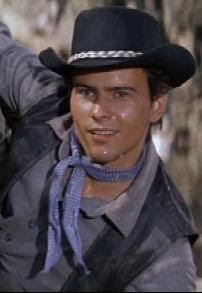 Here’s how the original German version of the movie poster looked.
Here’s how the original German version of the movie poster looked.
James Dean … surely most folks in my age bracket aren’t so smitten by their rose-colored nostalgia glasses that they have forgotten the popularity of his “persona” among young people of that ‘50s generation. Dean roared onto the screen in 1955 with what has now become a “classic film.”
Rebel Without a Cause is a 1955 American drama film about emotionally confused suburban, middle-class teenagers. Directed by Nicholas Ray, it offered both social commentary and an alternative to previous films depicting delinquents in urban slum environments. (Wiki)
Movies about urban slum delinquents? Yes, there were plenty of those, most notably the equally classic film from that same year that starred Glenn Ford.
Richard Dadier (Glenn Ford) is a teacher at North Manual High School, an inner-city school where many of the pupils, led by student Gregory Miller (Sidney Poitier), frequently engage in anti-social behavior. Dadier makes various attempts to engage the students’ interest in education, challenging both the school staff and the pupils. He is subjected to violence as well as duplicitous schemes; he first suspects Miller, but later realizes that Artie West (Vic Morrow) is the perpetrator, and challenges him in a classroom showdown.
Yes, Blackboard Jungle featured a 28-year old rising star (playing a teenage gang member) named Sidney Poitier.
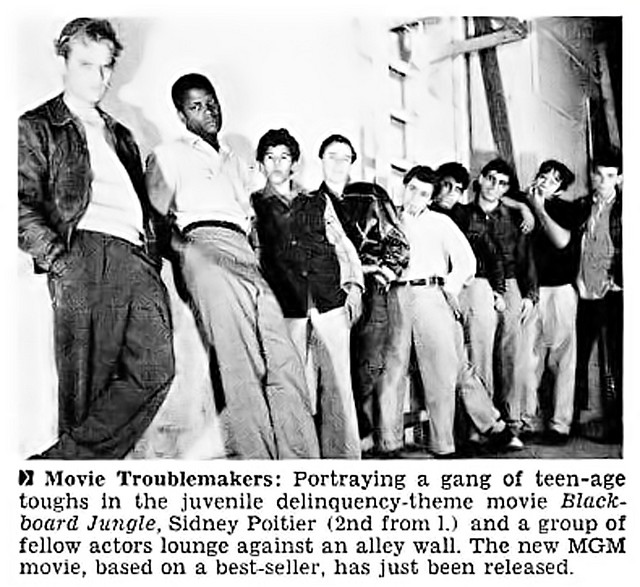 \Oh … and also featured, as the music behind the title credits, a new song that had just hit the charts the year before…
\Oh … and also featured, as the music behind the title credits, a new song that had just hit the charts the year before…
But if these two films were just a fluke, I wouldn’t be writing about them. The reality is that they were a symptom of a very pervasive issue of the 1950s.
Juvenile delinquency was considered a major social problem in the 1950s. Americans under the age of eighteen were committing serious crimes in growing numbers; their elders were horrified at the severity of the crimes and at the young criminals’ disregard for authority. Most of all, though, people were concerned about what the rate of juvenile crime said about how the nation was raising its children. Of course, there had always been youth crime in America, even vicious youth crime. But in the 1950s, because of the growth of cities across the United States, it became a national cause for concern.
As early as 1953 the statistics suggested a youth crime wave. FBI director J. Edgar Hoover reported: “persons under the age of 18 committed 53.6 percent of all car thefts; 49.3 percent of all burglaries; 18 percent of all robberies, and 16.2 percent of all rapes. These are the statistics..
As a result of these factors:
The United States Senate Subcommittee on Juvenile Delinquency was established by the United States Senate in 1953 to investigate the problem of juvenile delinquency.
The public hearings took place on April 21, 22, June 4, 1954 in New York. They focused on particularly graphic “crime and horror” comic books of the day, and their potential impact on juvenile delinquency. When publisher William Gaines [Gaines had begun publishing Mad Magazine in 1952, but also had a large stable of horror comics] contended that he sold only comic books of good taste, Kefauver entered into evidence one of Gaines’ comics which showed a dismembered woman’s head on its cover. The exchange between Gaines and Kefauver led to a front-page story in The New York Times the following day.
Chief Counsel Herbert Beaser asked: “Then you think a child cannot in any way, shape, or manner, be hurt by anything that the child reads or sees?” William M. Gaines responded: “I do not believe so.” Beaser: “There would be no limit, actually, to what you’d put in the magazines?” Gaines: “Only within the bounds of good taste.” Sen. Kefauver: “Here is your May issue. This seems to be a man with a bloody ax holding a woman’s head up which has been severed from her body. Do you think that’s in good taste?” Gaines: “Yes sir, I do – for the cover of a horror comic. A cover in bad taste, for example, might be defined as holding her head a little higher so that blood could be seen dripping from it and moving the body a little further over so that the neck of the body could be seen to be bloody.” Kefauver:(doubtful)”You’ve got blood coming out of her mouth.” Gaines: “A little.”
What none of the senators knew was that Gaines had already cleaned up the cover of this issue. Artist Johnny Craig’s first draft included those very elements which Gaines had said were in “bad taste” and had him clean it up before publication. (From Enotes.com)
Magazine articles and books abounded which dissected the growing menace of juvenile delinquency. I grew up in a small town of less than 10,000 in far northern Michigan. We had a few “greasers” or “hoods” in town, who wore long, greased-back hair (in the style known as the D.A. because in the back it looked like a duck’s… ahem…tail) and black leather jackets and played “chicken” with switchblades and such. Our own versions of The Fonz.
But it was mostly just for show. There were no real “gangs” and no actual hoodlum activity in town. So I wasn’t exposed very much to the kind of problems that went on in metropolitan areas.
But in my freshman year at Michigan State University in the fall of 1964, I met my new roommate, who was from Long Island, New York. She had a much more urban youth than mine, and would regale me with stories of the escapades of the girl gangs from her area. I particularly remember her explaining that they would tease their long hair into a “ratted” mass to create the beehive and other “big-hair” styles popular at the time … and then secretly tuck away within the tangled mass…razor blades. That way when the kind of “cat fights” that such girls got into began, and their “rivals” would grab a handful of their hair to try to yank it out, they’d get their hands bloodied.
And I recently found that this type of scenario was meticulously documented in a 1964 expose’ book of the time.
In Rebels in the Streets, the NY Daily News reporter Kitty Hanson suggested what no self respecting girl gang member would be caught without, and it wasn’t mascara: “Weapons include iron pipes, brass knuckles, bicycle chains, belt buckles, the honed handles of garbage can lids, beer can openers, radio antennas sharpened into sabres, knives (of course) and guns.” (From Freebirdbooks.blogspot.com)
Not to be outdone by the ladies, of course, the young male gang members of the time had bigger and badder arsenals, as described in this 1962 investigative reporting book, The Shook Up Generation.
The variety of gang weapons is endless. Some possess hand grenades, dynamite-and-caps or acid bottles. One gang leader in Queens goes into battle with a can of lye into which he has urinated. Broken bottles, steel chains, lead pipes, tire irons–almost anything makes a deadly weapon in street combat.
There is a Brooklyn gang which is known to have in the arsenal half a dozen old Navy cutlasses. Machetes are common because they can be bought from a bin in many hardware stores. Some boys make Molotov cocktails…
The automobile, where gang members have access to it, is the most feared weapon. It inspires the kind of terror among street boys that the tank aroused when it was sent against infantry in World War I. Cars are driven with lethal intent straight at enemy boys. A youngster trapped in the open street is simply run down. Survival is sheer luck. (ibid)
As early as 1949, the juvenile delinquency epidemic had started enough to make it a hot topic for comic books like this one.
And the topic even made it onto Broadway in 1957 with West Side Story, with its battles between the Jets and the Sharks.
But the subject was most publicly noticeable during the 1950s through the never-ending stream of “teen exploitation films” that homed in on delinquents for an extended period in the decade. Rebel and Jungle were two highly acclaimed movies for their cinematic values. Most of the rest of the genre didn’t quite rise to that standard…
I hope that this commentary and the few photos might prod some readers toward realizing that the view through their rose-colored nostalgia glasses about their own youth is creating an illusion of the past for them when it comes to thinking the decade of the 1950s was some idyllic time when youths were almost all perfect Little Lord Fauntleroys. (Who was, of course, a fictional character from an 1886 novel, unlike almost all youth of his own time too.)
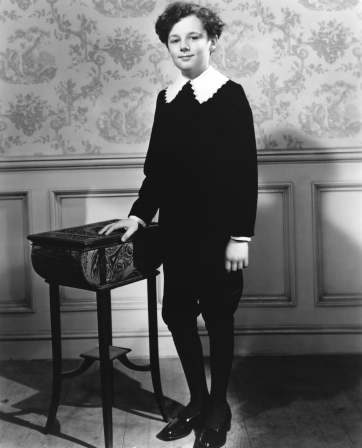 Freddy Bartholomew, age 12, in the 1936 movie Little Lord Fauntleroy
Freddy Bartholomew, age 12, in the 1936 movie Little Lord Fauntleroy
In fact, it’s not just Baby Boomers who have hung on to an illusion of the ‘50s as God’s Decade. My daughter was born in 1970. By the mid-1980s, she had developed an illusion of her own about the ‘50s. It was as a result of all of the re-runs on TV of ‘50s shows, like I Love Lucy, and ‘50s themed shows, such as Happy Days. It all seemed so appealing to her in her own early teens, when she wasn’t quite sure how to fit into the “current” teen scene. It was much less threatening to daydream what it would have been like to hang out with Richie and Joanie Cunningham at Arnold’s Drive-in. Even the resident “greaser,” The Fonz, seemed like a real pussycat.
She admits she fell for the illusion totally, and assumed that indeed, the whole society of the 1950s would have been like living with the Cunninghams. She found herself actually estranged from her own peers in favor of this illusion world—even though her teen peers were primarily the kids at a very wholesome Christian high school! (She found it even harder to even pass “unknown” teenagers in the hallway when shopping at the mall–just their very existence, because of images she’d seen on TV and in movies about contemporary youth culture of the ’80s, seemed threatening.)
She now realizes that the youths in the generation she grew up with (and now the generation her own teen son and daughter are growing up with) were really very little different from most youths in the 1950s. There were good aspects and bad in the youth culture of that decade, just like every other decade. Kids then and now have issues about working toward establishing independence from their parents. Those of both eras have had to deal with the strong pulls of sexuality. And with the strong influences of peer pressure. Both eras have had subcultures of gangs.
If the prognostications of many TV and Internet evangelists about Jesus returning real soon to set up His earthly Kingdom happen to be false, this generation of youths are going to become adults. They will have the responsibility to take civilization forward. I cannot fathom how Christians cannot see that we must NOT just “write off” the young of our generation, and cling to some useless nostalgia for the past, and a rabid insistence that Jesus IS Coming in the immediate future. What Christians really need to do is reach out to the youth of the 21st century with the love of Jesus, and the wisdom of the Bible that could help them MAYBE even make some changes for the better on Earth while we are all waiting for the “Someday” Kingdom.
For more consideration of the era of the 1950s, continue on to the next blog entry in this series,

